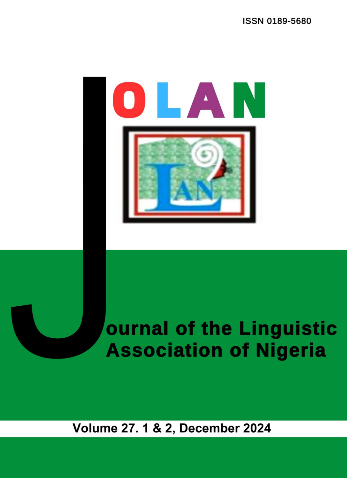A grammatical study of reduplication in Mwaghavul
DOI:
https://doi.org/10.60787/jolan.vol27no1-2.392Keywords:
Reduplication, Base form, Derived form, Grammatical function, MwaghavulAbstract
This article examines grammatical aspects of reduplication in Mwaghavul, a Western Chadic language spoken in Plateau State, North Central Nigeria. Using a corpus of selected reduplicated words in the Mwaghavul dictionary and the native intuition of selected speakers of the language, the study aims at identifying the grammatical functions of reduplication in the Mwaghavul language. Findings of the research indicate that reduplication, alongside tonal changes in some instances, grammatically functions to indicate distributiveness in cardinal numerals, intensification/emphasis in adjectival verbs, relativity in colour adjectives, and imperative mood in some verbs. Other grammatical roles of reduplication are to mark repetitive actions, modal changes, verb focus, derivation of predicative adjectives from verbs, and the formation of a special type of alternative question in the language, among other things. The study concludes that the process of reduplication in the Mwaghavul language is signalled by the interface of morphophonological and syntactic phenomena.
References
Alsamadani, M. & Talbah, S. (2019). Types and functions of reduplication in Palembang. Journal of the Southeast Asian Linguistics Society (JSEALS), 12 (1), 113-142.
Arokoyo, B. E. & Fwangwar, T. R. (2019). Reduplication in Mwaghavul: A tonal analysis. Inquiry in African Languages, 2, 1-11.
Blench, R. (2012). An atlas of Nigerian languages. Cambridge: Kay Williamson Educational Foundation.
Blench, R., Dawum, R., Daapya, N. F., & Bess, Y. J. (2021). Mwaghavul-English dictionary. Unpublished manuscript. https://www.academia.edu/resource/work/3764864
Eberhard, D. M., Simons, G. F. & Fennig, C. D. (2019). Ethnologue: Languages of the world. (22nd ed.). SIL International. http://www.ethnologue.com
Frajzyngier, Z. (1993). A grammar of Mupun. Berlin: Dietrich Reimer.
Fwangwar, T. R. (2018). Aspects of the phonology of Mwaghavul. Unpublished M.A. thesis, University of Ilorin.
Haspelmath, M. & Sims, A. D. (2010).Understanding morphology. Hodder Education.
Inkelas, S & Downing, L. J. (2015). What is reduplication? Typology and analysis part 1/2: The typology of reduplication. https://doi.org/10.1111/Inc3.12166
José, B. (2004). The prosodic morphology of (historical) Hausa verb reduplication. Proceedings from the Annual Meeting of the Chicago Linguistics Society, 40(2), 103-117.
Lieber, R. (2009). Introducing morphology. Cambridge University Press.
Maduagwu, G. O. (2012). Reduplication in Tiv. Multidisciplinary Journal of Empirical Research, 10 (1), 1-6.
Nyang, S., Bess, J. & Dawum, R. (2013). Mwaghavul orthography. Mwaghavul Bible Translation Committee.
Ratcliffe, R. R. (1996). Drift and noun plural reduplication in Afroasiatic. Bulletin of the School of Oriental and African Studies, 59, 296-311.
Schuh, R. G. (2002). The locus of pluractional reduplication in West Chadic. Unpublished ms. http://www.linguistics.ucla.edu/people/schuh/Papers/WC_redup.pdf
Downloads
Published
How to Cite
Issue
Section
License
Copyright (c) 2024 Journal of The Linguistic Association of Nigeria

This work is licensed under a Creative Commons Attribution-NonCommercial-ShareAlike 4.0 International License.













